Exploring the Challenge of Leadership in Today's Complex World
VerifiedAdded on 2023/03/23
|9
|2351
|25
Essay
AI Summary
This essay delves into the multifaceted challenges of leadership in today's dynamic world, examining both internal and external factors that impact organizational effectiveness. It identifies key challenges such as developing managerial effectiveness, employee development across generations, guiding organizational change, managing internal stakeholders, and inspiring others. The essay emphasizes the importance of reliable communication, relationship-driven leadership, clear goals and objectives, and wise delegation to overcome these challenges. It also provides recommendations for improving leadership development programs, including fostering a passion for training and coaching, building trust within the organization, and offering flexible learning options for employees. The analysis underscores the need for leaders to adapt their approaches to meet the complexities and uncertainties of the modern organizational landscape.
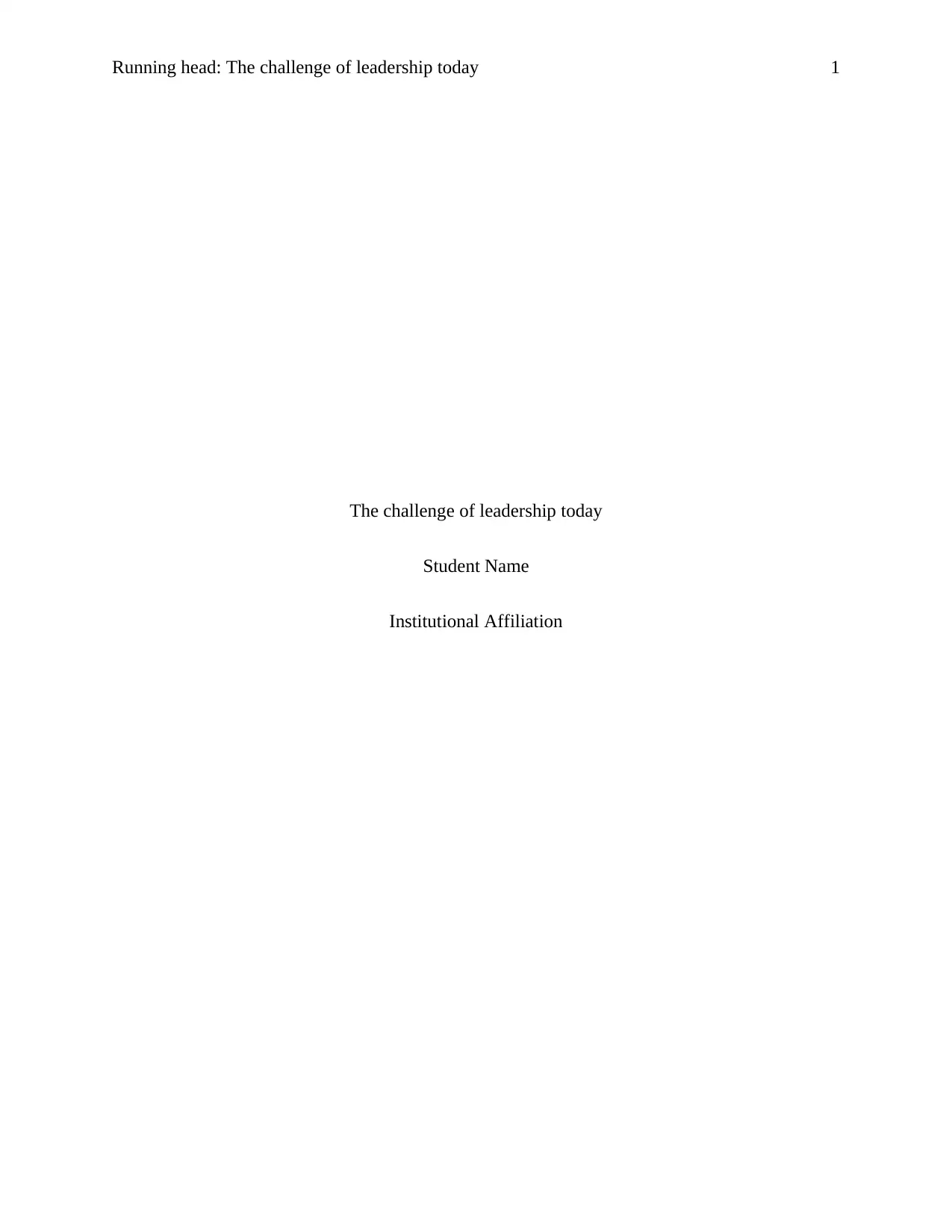
Running head: The challenge of leadership today 1
The challenge of leadership today
Student Name
Institutional Affiliation
The challenge of leadership today
Student Name
Institutional Affiliation
Paraphrase This Document
Need a fresh take? Get an instant paraphrase of this document with our AI Paraphraser
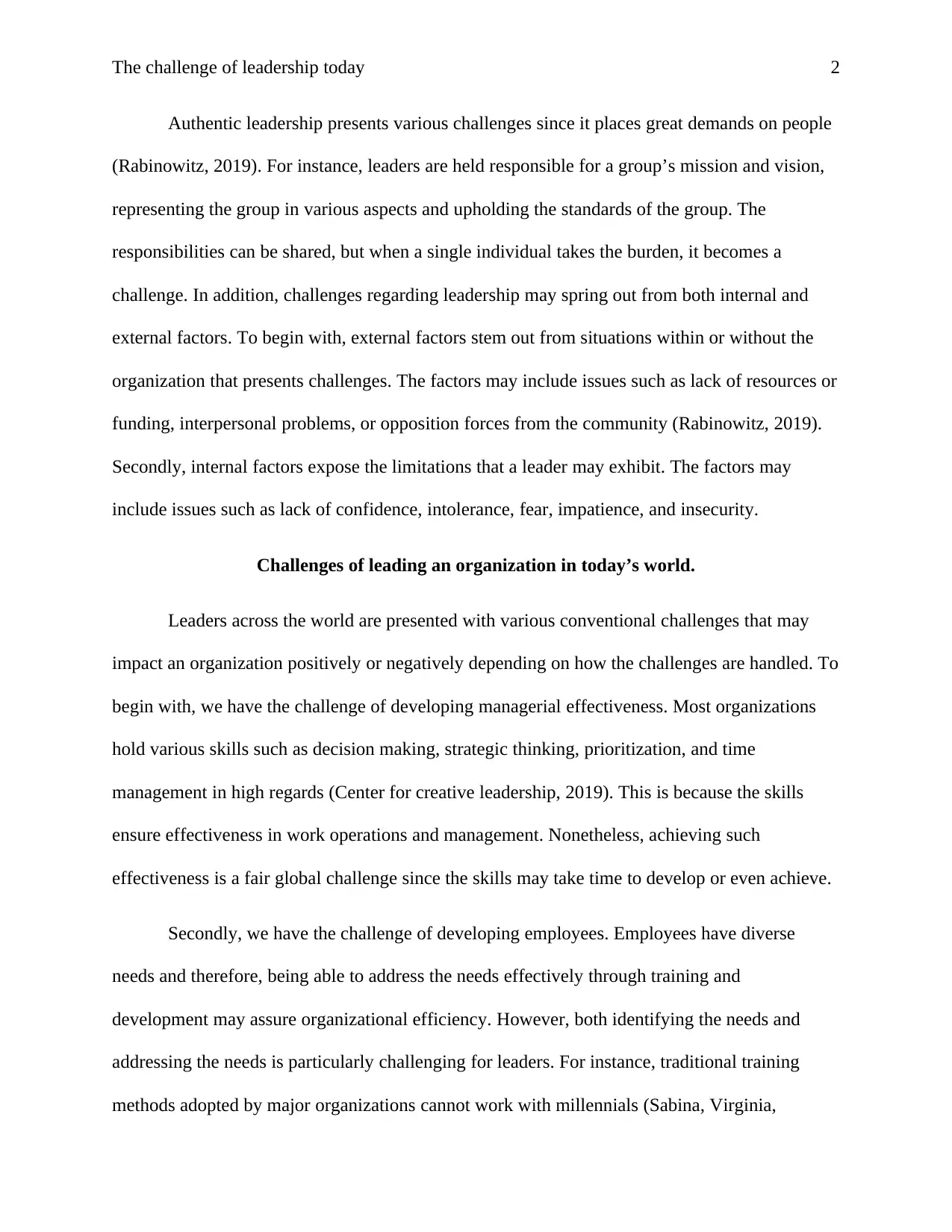
The challenge of leadership today 2
Authentic leadership presents various challenges since it places great demands on people
(Rabinowitz, 2019). For instance, leaders are held responsible for a group’s mission and vision,
representing the group in various aspects and upholding the standards of the group. The
responsibilities can be shared, but when a single individual takes the burden, it becomes a
challenge. In addition, challenges regarding leadership may spring out from both internal and
external factors. To begin with, external factors stem out from situations within or without the
organization that presents challenges. The factors may include issues such as lack of resources or
funding, interpersonal problems, or opposition forces from the community (Rabinowitz, 2019).
Secondly, internal factors expose the limitations that a leader may exhibit. The factors may
include issues such as lack of confidence, intolerance, fear, impatience, and insecurity.
Challenges of leading an organization in today’s world.
Leaders across the world are presented with various conventional challenges that may
impact an organization positively or negatively depending on how the challenges are handled. To
begin with, we have the challenge of developing managerial effectiveness. Most organizations
hold various skills such as decision making, strategic thinking, prioritization, and time
management in high regards (Center for creative leadership, 2019). This is because the skills
ensure effectiveness in work operations and management. Nonetheless, achieving such
effectiveness is a fair global challenge since the skills may take time to develop or even achieve.
Secondly, we have the challenge of developing employees. Employees have diverse
needs and therefore, being able to address the needs effectively through training and
development may assure organizational efficiency. However, both identifying the needs and
addressing the needs is particularly challenging for leaders. For instance, traditional training
methods adopted by major organizations cannot work with millennials (Sabina, Virginia,
Authentic leadership presents various challenges since it places great demands on people
(Rabinowitz, 2019). For instance, leaders are held responsible for a group’s mission and vision,
representing the group in various aspects and upholding the standards of the group. The
responsibilities can be shared, but when a single individual takes the burden, it becomes a
challenge. In addition, challenges regarding leadership may spring out from both internal and
external factors. To begin with, external factors stem out from situations within or without the
organization that presents challenges. The factors may include issues such as lack of resources or
funding, interpersonal problems, or opposition forces from the community (Rabinowitz, 2019).
Secondly, internal factors expose the limitations that a leader may exhibit. The factors may
include issues such as lack of confidence, intolerance, fear, impatience, and insecurity.
Challenges of leading an organization in today’s world.
Leaders across the world are presented with various conventional challenges that may
impact an organization positively or negatively depending on how the challenges are handled. To
begin with, we have the challenge of developing managerial effectiveness. Most organizations
hold various skills such as decision making, strategic thinking, prioritization, and time
management in high regards (Center for creative leadership, 2019). This is because the skills
ensure effectiveness in work operations and management. Nonetheless, achieving such
effectiveness is a fair global challenge since the skills may take time to develop or even achieve.
Secondly, we have the challenge of developing employees. Employees have diverse
needs and therefore, being able to address the needs effectively through training and
development may assure organizational efficiency. However, both identifying the needs and
addressing the needs is particularly challenging for leaders. For instance, traditional training
methods adopted by major organizations cannot work with millennials (Sabina, Virginia,
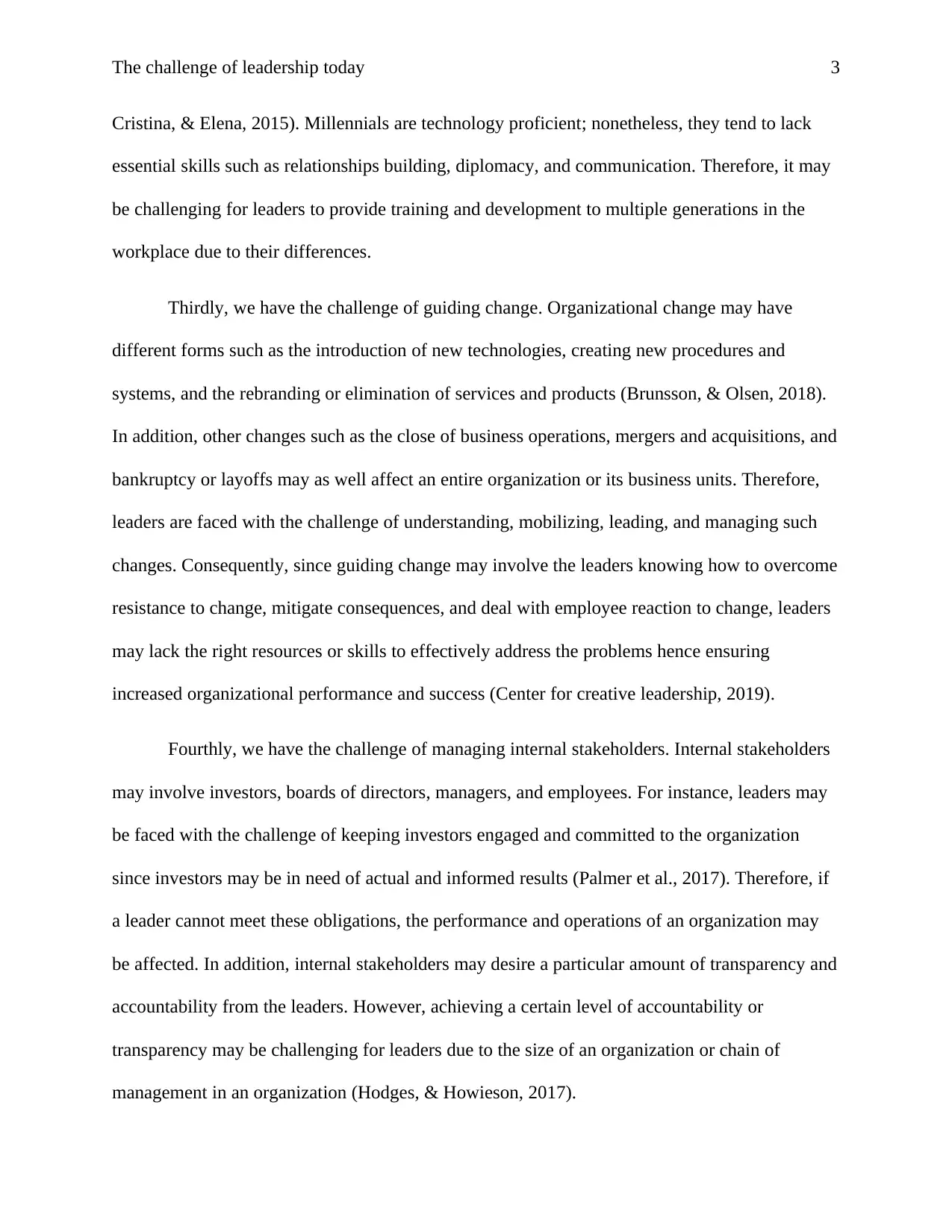
The challenge of leadership today 3
Cristina, & Elena, 2015). Millennials are technology proficient; nonetheless, they tend to lack
essential skills such as relationships building, diplomacy, and communication. Therefore, it may
be challenging for leaders to provide training and development to multiple generations in the
workplace due to their differences.
Thirdly, we have the challenge of guiding change. Organizational change may have
different forms such as the introduction of new technologies, creating new procedures and
systems, and the rebranding or elimination of services and products (Brunsson, & Olsen, 2018).
In addition, other changes such as the close of business operations, mergers and acquisitions, and
bankruptcy or layoffs may as well affect an entire organization or its business units. Therefore,
leaders are faced with the challenge of understanding, mobilizing, leading, and managing such
changes. Consequently, since guiding change may involve the leaders knowing how to overcome
resistance to change, mitigate consequences, and deal with employee reaction to change, leaders
may lack the right resources or skills to effectively address the problems hence ensuring
increased organizational performance and success (Center for creative leadership, 2019).
Fourthly, we have the challenge of managing internal stakeholders. Internal stakeholders
may involve investors, boards of directors, managers, and employees. For instance, leaders may
be faced with the challenge of keeping investors engaged and committed to the organization
since investors may be in need of actual and informed results (Palmer et al., 2017). Therefore, if
a leader cannot meet these obligations, the performance and operations of an organization may
be affected. In addition, internal stakeholders may desire a particular amount of transparency and
accountability from the leaders. However, achieving a certain level of accountability or
transparency may be challenging for leaders due to the size of an organization or chain of
management in an organization (Hodges, & Howieson, 2017).
Cristina, & Elena, 2015). Millennials are technology proficient; nonetheless, they tend to lack
essential skills such as relationships building, diplomacy, and communication. Therefore, it may
be challenging for leaders to provide training and development to multiple generations in the
workplace due to their differences.
Thirdly, we have the challenge of guiding change. Organizational change may have
different forms such as the introduction of new technologies, creating new procedures and
systems, and the rebranding or elimination of services and products (Brunsson, & Olsen, 2018).
In addition, other changes such as the close of business operations, mergers and acquisitions, and
bankruptcy or layoffs may as well affect an entire organization or its business units. Therefore,
leaders are faced with the challenge of understanding, mobilizing, leading, and managing such
changes. Consequently, since guiding change may involve the leaders knowing how to overcome
resistance to change, mitigate consequences, and deal with employee reaction to change, leaders
may lack the right resources or skills to effectively address the problems hence ensuring
increased organizational performance and success (Center for creative leadership, 2019).
Fourthly, we have the challenge of managing internal stakeholders. Internal stakeholders
may involve investors, boards of directors, managers, and employees. For instance, leaders may
be faced with the challenge of keeping investors engaged and committed to the organization
since investors may be in need of actual and informed results (Palmer et al., 2017). Therefore, if
a leader cannot meet these obligations, the performance and operations of an organization may
be affected. In addition, internal stakeholders may desire a particular amount of transparency and
accountability from the leaders. However, achieving a certain level of accountability or
transparency may be challenging for leaders due to the size of an organization or chain of
management in an organization (Hodges, & Howieson, 2017).
⊘ This is a preview!⊘
Do you want full access?
Subscribe today to unlock all pages.

Trusted by 1+ million students worldwide
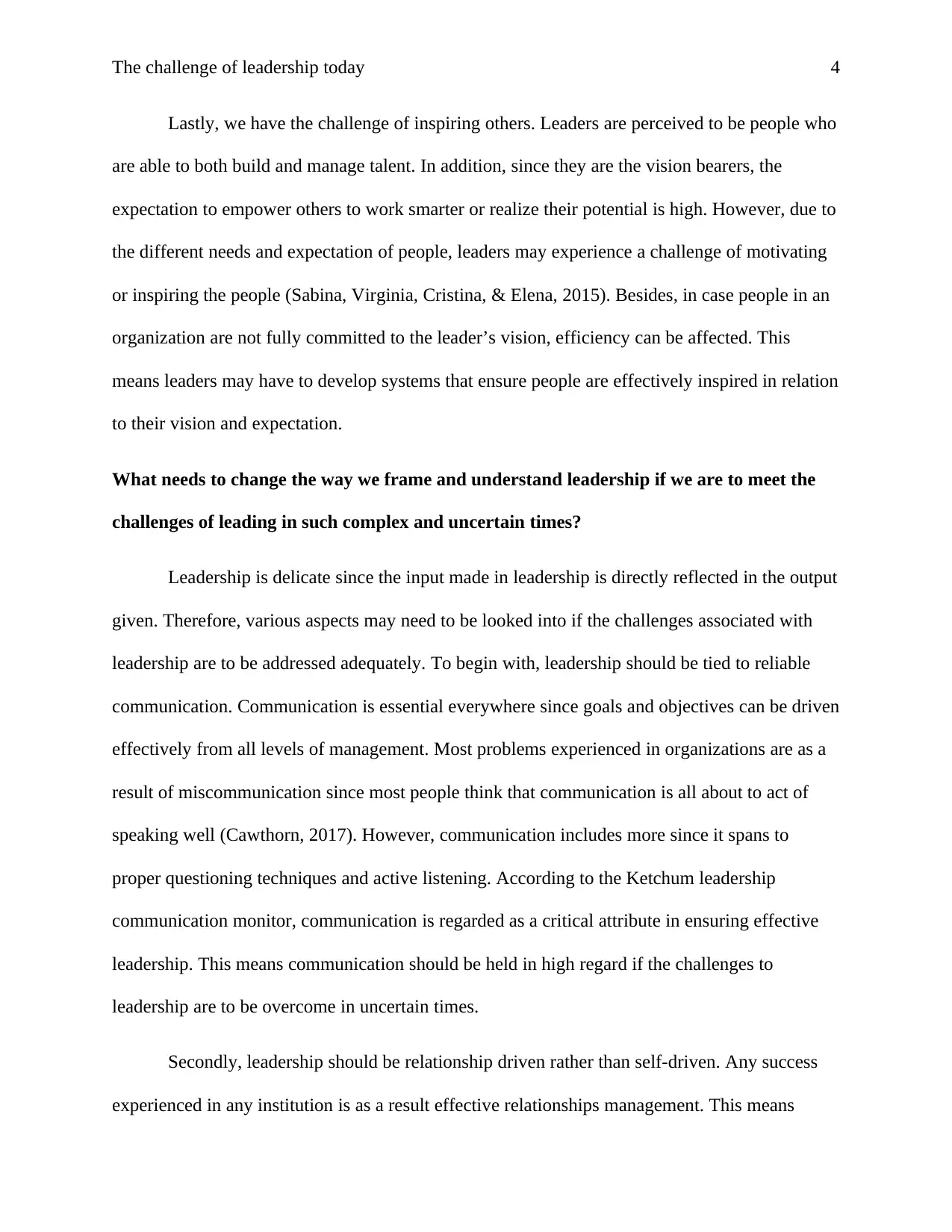
The challenge of leadership today 4
Lastly, we have the challenge of inspiring others. Leaders are perceived to be people who
are able to both build and manage talent. In addition, since they are the vision bearers, the
expectation to empower others to work smarter or realize their potential is high. However, due to
the different needs and expectation of people, leaders may experience a challenge of motivating
or inspiring the people (Sabina, Virginia, Cristina, & Elena, 2015). Besides, in case people in an
organization are not fully committed to the leader’s vision, efficiency can be affected. This
means leaders may have to develop systems that ensure people are effectively inspired in relation
to their vision and expectation.
What needs to change the way we frame and understand leadership if we are to meet the
challenges of leading in such complex and uncertain times?
Leadership is delicate since the input made in leadership is directly reflected in the output
given. Therefore, various aspects may need to be looked into if the challenges associated with
leadership are to be addressed adequately. To begin with, leadership should be tied to reliable
communication. Communication is essential everywhere since goals and objectives can be driven
effectively from all levels of management. Most problems experienced in organizations are as a
result of miscommunication since most people think that communication is all about to act of
speaking well (Cawthorn, 2017). However, communication includes more since it spans to
proper questioning techniques and active listening. According to the Ketchum leadership
communication monitor, communication is regarded as a critical attribute in ensuring effective
leadership. This means communication should be held in high regard if the challenges to
leadership are to be overcome in uncertain times.
Secondly, leadership should be relationship driven rather than self-driven. Any success
experienced in any institution is as a result effective relationships management. This means
Lastly, we have the challenge of inspiring others. Leaders are perceived to be people who
are able to both build and manage talent. In addition, since they are the vision bearers, the
expectation to empower others to work smarter or realize their potential is high. However, due to
the different needs and expectation of people, leaders may experience a challenge of motivating
or inspiring the people (Sabina, Virginia, Cristina, & Elena, 2015). Besides, in case people in an
organization are not fully committed to the leader’s vision, efficiency can be affected. This
means leaders may have to develop systems that ensure people are effectively inspired in relation
to their vision and expectation.
What needs to change the way we frame and understand leadership if we are to meet the
challenges of leading in such complex and uncertain times?
Leadership is delicate since the input made in leadership is directly reflected in the output
given. Therefore, various aspects may need to be looked into if the challenges associated with
leadership are to be addressed adequately. To begin with, leadership should be tied to reliable
communication. Communication is essential everywhere since goals and objectives can be driven
effectively from all levels of management. Most problems experienced in organizations are as a
result of miscommunication since most people think that communication is all about to act of
speaking well (Cawthorn, 2017). However, communication includes more since it spans to
proper questioning techniques and active listening. According to the Ketchum leadership
communication monitor, communication is regarded as a critical attribute in ensuring effective
leadership. This means communication should be held in high regard if the challenges to
leadership are to be overcome in uncertain times.
Secondly, leadership should be relationship driven rather than self-driven. Any success
experienced in any institution is as a result effective relationships management. This means
Paraphrase This Document
Need a fresh take? Get an instant paraphrase of this document with our AI Paraphraser
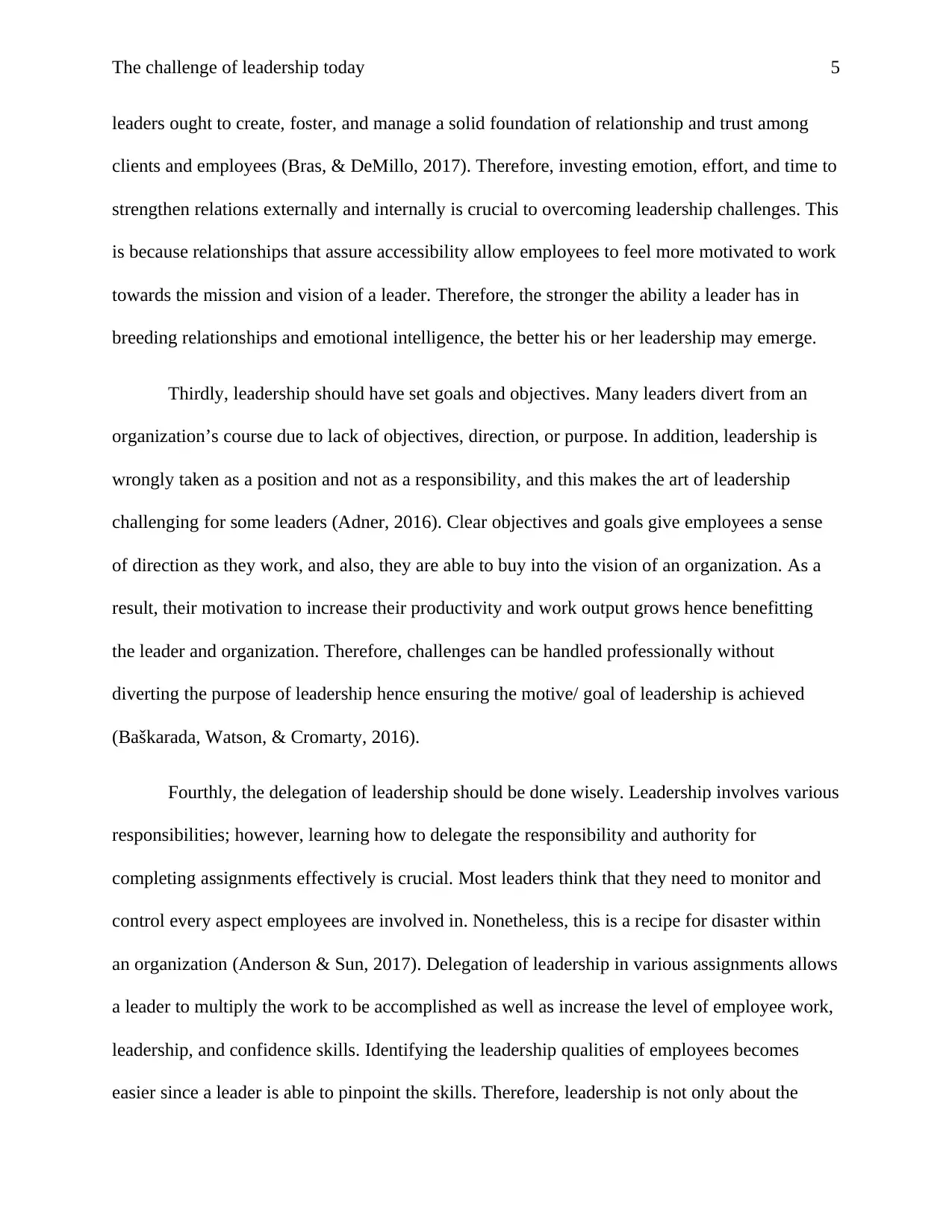
The challenge of leadership today 5
leaders ought to create, foster, and manage a solid foundation of relationship and trust among
clients and employees (Bras, & DeMillo, 2017). Therefore, investing emotion, effort, and time to
strengthen relations externally and internally is crucial to overcoming leadership challenges. This
is because relationships that assure accessibility allow employees to feel more motivated to work
towards the mission and vision of a leader. Therefore, the stronger the ability a leader has in
breeding relationships and emotional intelligence, the better his or her leadership may emerge.
Thirdly, leadership should have set goals and objectives. Many leaders divert from an
organization’s course due to lack of objectives, direction, or purpose. In addition, leadership is
wrongly taken as a position and not as a responsibility, and this makes the art of leadership
challenging for some leaders (Adner, 2016). Clear objectives and goals give employees a sense
of direction as they work, and also, they are able to buy into the vision of an organization. As a
result, their motivation to increase their productivity and work output grows hence benefitting
the leader and organization. Therefore, challenges can be handled professionally without
diverting the purpose of leadership hence ensuring the motive/ goal of leadership is achieved
(Baškarada, Watson, & Cromarty, 2016).
Fourthly, the delegation of leadership should be done wisely. Leadership involves various
responsibilities; however, learning how to delegate the responsibility and authority for
completing assignments effectively is crucial. Most leaders think that they need to monitor and
control every aspect employees are involved in. Nonetheless, this is a recipe for disaster within
an organization (Anderson & Sun, 2017). Delegation of leadership in various assignments allows
a leader to multiply the work to be accomplished as well as increase the level of employee work,
leadership, and confidence skills. Identifying the leadership qualities of employees becomes
easier since a leader is able to pinpoint the skills. Therefore, leadership is not only about the
leaders ought to create, foster, and manage a solid foundation of relationship and trust among
clients and employees (Bras, & DeMillo, 2017). Therefore, investing emotion, effort, and time to
strengthen relations externally and internally is crucial to overcoming leadership challenges. This
is because relationships that assure accessibility allow employees to feel more motivated to work
towards the mission and vision of a leader. Therefore, the stronger the ability a leader has in
breeding relationships and emotional intelligence, the better his or her leadership may emerge.
Thirdly, leadership should have set goals and objectives. Many leaders divert from an
organization’s course due to lack of objectives, direction, or purpose. In addition, leadership is
wrongly taken as a position and not as a responsibility, and this makes the art of leadership
challenging for some leaders (Adner, 2016). Clear objectives and goals give employees a sense
of direction as they work, and also, they are able to buy into the vision of an organization. As a
result, their motivation to increase their productivity and work output grows hence benefitting
the leader and organization. Therefore, challenges can be handled professionally without
diverting the purpose of leadership hence ensuring the motive/ goal of leadership is achieved
(Baškarada, Watson, & Cromarty, 2016).
Fourthly, the delegation of leadership should be done wisely. Leadership involves various
responsibilities; however, learning how to delegate the responsibility and authority for
completing assignments effectively is crucial. Most leaders think that they need to monitor and
control every aspect employees are involved in. Nonetheless, this is a recipe for disaster within
an organization (Anderson & Sun, 2017). Delegation of leadership in various assignments allows
a leader to multiply the work to be accomplished as well as increase the level of employee work,
leadership, and confidence skills. Identifying the leadership qualities of employees becomes
easier since a leader is able to pinpoint the skills. Therefore, leadership is not only about the
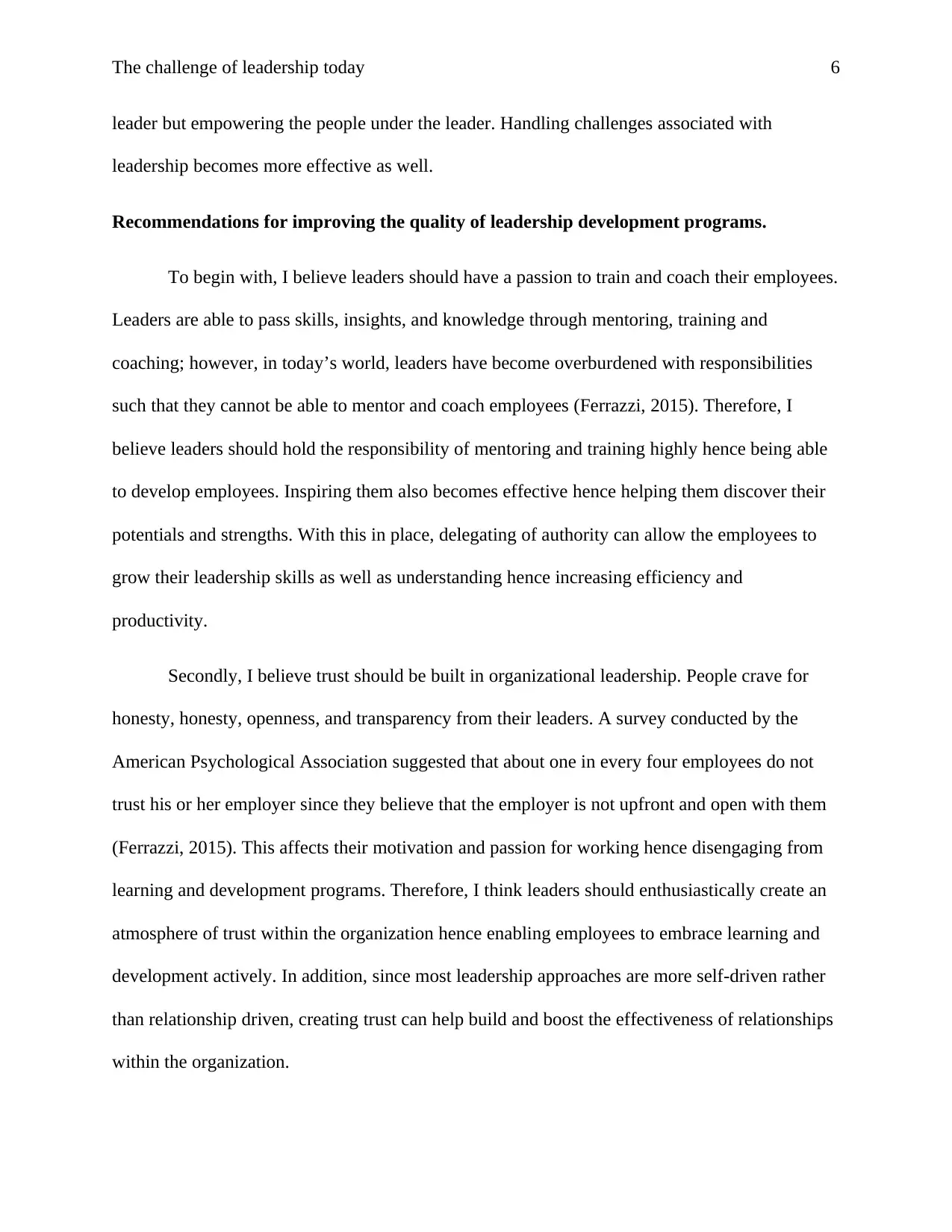
The challenge of leadership today 6
leader but empowering the people under the leader. Handling challenges associated with
leadership becomes more effective as well.
Recommendations for improving the quality of leadership development programs.
To begin with, I believe leaders should have a passion to train and coach their employees.
Leaders are able to pass skills, insights, and knowledge through mentoring, training and
coaching; however, in today’s world, leaders have become overburdened with responsibilities
such that they cannot be able to mentor and coach employees (Ferrazzi, 2015). Therefore, I
believe leaders should hold the responsibility of mentoring and training highly hence being able
to develop employees. Inspiring them also becomes effective hence helping them discover their
potentials and strengths. With this in place, delegating of authority can allow the employees to
grow their leadership skills as well as understanding hence increasing efficiency and
productivity.
Secondly, I believe trust should be built in organizational leadership. People crave for
honesty, honesty, openness, and transparency from their leaders. A survey conducted by the
American Psychological Association suggested that about one in every four employees do not
trust his or her employer since they believe that the employer is not upfront and open with them
(Ferrazzi, 2015). This affects their motivation and passion for working hence disengaging from
learning and development programs. Therefore, I think leaders should enthusiastically create an
atmosphere of trust within the organization hence enabling employees to embrace learning and
development actively. In addition, since most leadership approaches are more self-driven rather
than relationship driven, creating trust can help build and boost the effectiveness of relationships
within the organization.
leader but empowering the people under the leader. Handling challenges associated with
leadership becomes more effective as well.
Recommendations for improving the quality of leadership development programs.
To begin with, I believe leaders should have a passion to train and coach their employees.
Leaders are able to pass skills, insights, and knowledge through mentoring, training and
coaching; however, in today’s world, leaders have become overburdened with responsibilities
such that they cannot be able to mentor and coach employees (Ferrazzi, 2015). Therefore, I
believe leaders should hold the responsibility of mentoring and training highly hence being able
to develop employees. Inspiring them also becomes effective hence helping them discover their
potentials and strengths. With this in place, delegating of authority can allow the employees to
grow their leadership skills as well as understanding hence increasing efficiency and
productivity.
Secondly, I believe trust should be built in organizational leadership. People crave for
honesty, honesty, openness, and transparency from their leaders. A survey conducted by the
American Psychological Association suggested that about one in every four employees do not
trust his or her employer since they believe that the employer is not upfront and open with them
(Ferrazzi, 2015). This affects their motivation and passion for working hence disengaging from
learning and development programs. Therefore, I think leaders should enthusiastically create an
atmosphere of trust within the organization hence enabling employees to embrace learning and
development actively. In addition, since most leadership approaches are more self-driven rather
than relationship driven, creating trust can help build and boost the effectiveness of relationships
within the organization.
⊘ This is a preview!⊘
Do you want full access?
Subscribe today to unlock all pages.

Trusted by 1+ million students worldwide
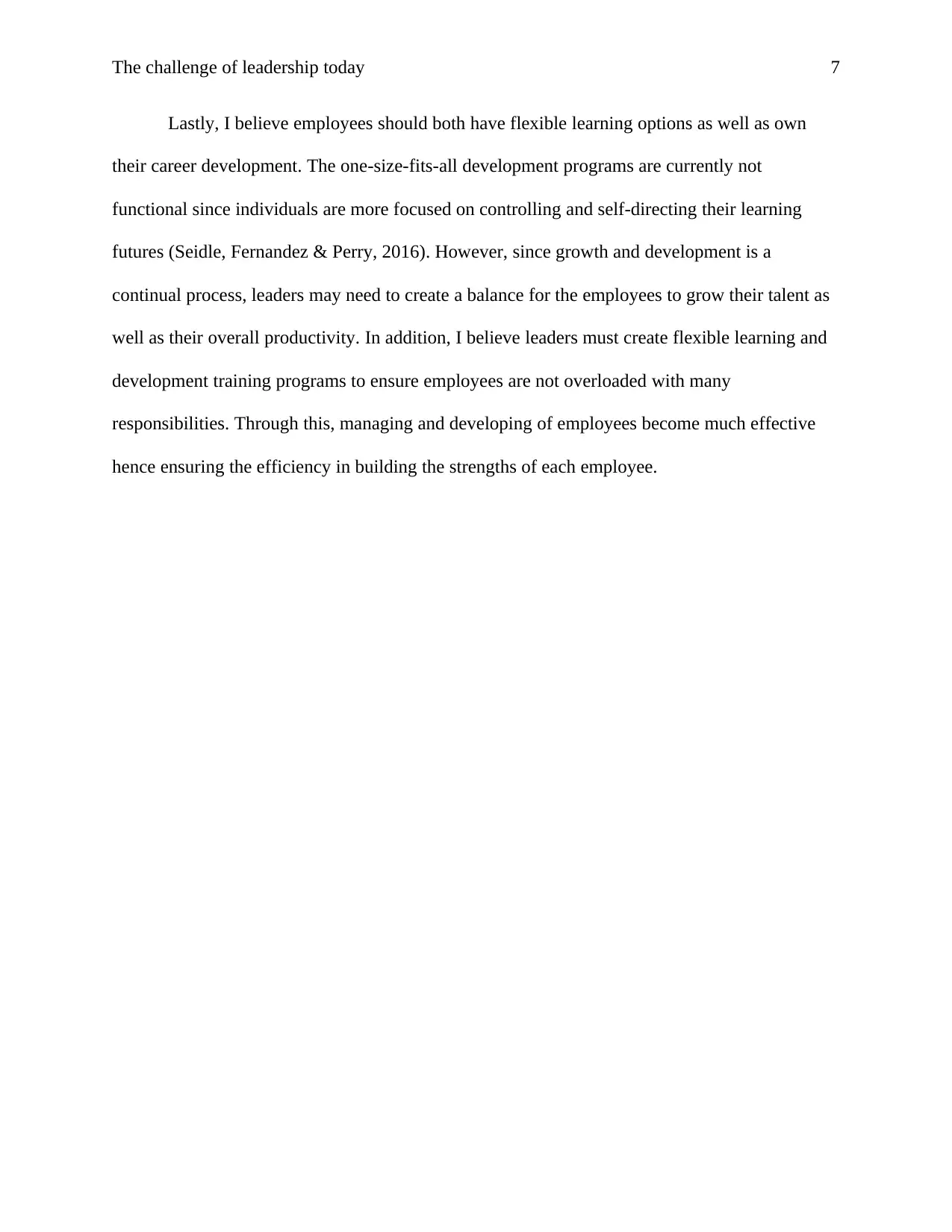
The challenge of leadership today 7
Lastly, I believe employees should both have flexible learning options as well as own
their career development. The one-size-fits-all development programs are currently not
functional since individuals are more focused on controlling and self-directing their learning
futures (Seidle, Fernandez & Perry, 2016). However, since growth and development is a
continual process, leaders may need to create a balance for the employees to grow their talent as
well as their overall productivity. In addition, I believe leaders must create flexible learning and
development training programs to ensure employees are not overloaded with many
responsibilities. Through this, managing and developing of employees become much effective
hence ensuring the efficiency in building the strengths of each employee.
Lastly, I believe employees should both have flexible learning options as well as own
their career development. The one-size-fits-all development programs are currently not
functional since individuals are more focused on controlling and self-directing their learning
futures (Seidle, Fernandez & Perry, 2016). However, since growth and development is a
continual process, leaders may need to create a balance for the employees to grow their talent as
well as their overall productivity. In addition, I believe leaders must create flexible learning and
development training programs to ensure employees are not overloaded with many
responsibilities. Through this, managing and developing of employees become much effective
hence ensuring the efficiency in building the strengths of each employee.
Paraphrase This Document
Need a fresh take? Get an instant paraphrase of this document with our AI Paraphraser
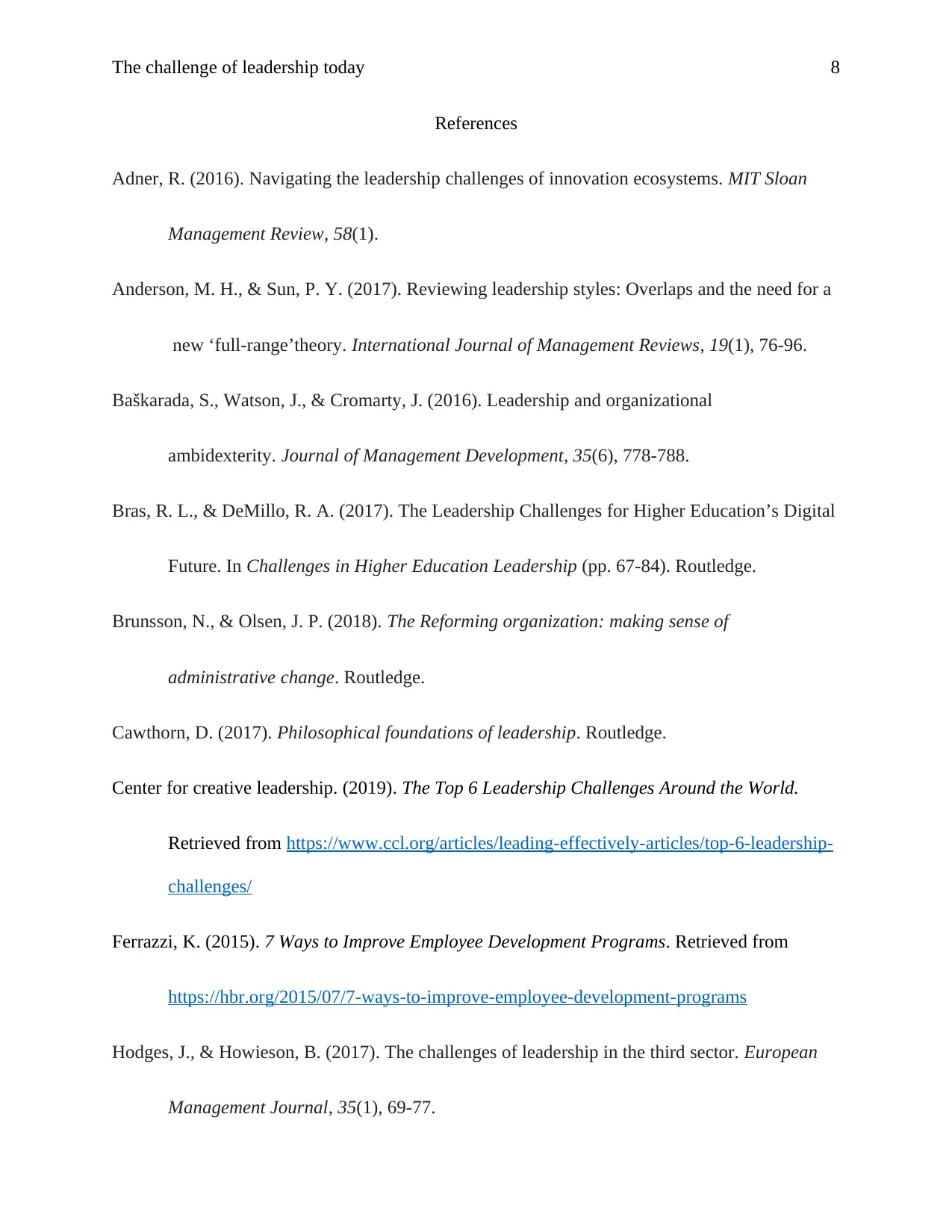
The challenge of leadership today 8
References
Adner, R. (2016). Navigating the leadership challenges of innovation ecosystems. MIT Sloan
Management Review, 58(1).
Anderson, M. H., & Sun, P. Y. (2017). Reviewing leadership styles: Overlaps and the need for a
new ‘full‐range’theory. International Journal of Management Reviews, 19(1), 76-96.
Baškarada, S., Watson, J., & Cromarty, J. (2016). Leadership and organizational
ambidexterity. Journal of Management Development, 35(6), 778-788.
Bras, R. L., & DeMillo, R. A. (2017). The Leadership Challenges for Higher Education’s Digital
Future. In Challenges in Higher Education Leadership (pp. 67-84). Routledge.
Brunsson, N., & Olsen, J. P. (2018). The Reforming organization: making sense of
administrative change. Routledge.
Cawthorn, D. (2017). Philosophical foundations of leadership. Routledge.
Center for creative leadership. (2019). The Top 6 Leadership Challenges Around the World.
Retrieved from https://www.ccl.org/articles/leading-effectively-articles/top-6-leadership-
challenges/
Ferrazzi, K. (2015). 7 Ways to Improve Employee Development Programs. Retrieved from
https://hbr.org/2015/07/7-ways-to-improve-employee-development-programs
Hodges, J., & Howieson, B. (2017). The challenges of leadership in the third sector. European
Management Journal, 35(1), 69-77.
References
Adner, R. (2016). Navigating the leadership challenges of innovation ecosystems. MIT Sloan
Management Review, 58(1).
Anderson, M. H., & Sun, P. Y. (2017). Reviewing leadership styles: Overlaps and the need for a
new ‘full‐range’theory. International Journal of Management Reviews, 19(1), 76-96.
Baškarada, S., Watson, J., & Cromarty, J. (2016). Leadership and organizational
ambidexterity. Journal of Management Development, 35(6), 778-788.
Bras, R. L., & DeMillo, R. A. (2017). The Leadership Challenges for Higher Education’s Digital
Future. In Challenges in Higher Education Leadership (pp. 67-84). Routledge.
Brunsson, N., & Olsen, J. P. (2018). The Reforming organization: making sense of
administrative change. Routledge.
Cawthorn, D. (2017). Philosophical foundations of leadership. Routledge.
Center for creative leadership. (2019). The Top 6 Leadership Challenges Around the World.
Retrieved from https://www.ccl.org/articles/leading-effectively-articles/top-6-leadership-
challenges/
Ferrazzi, K. (2015). 7 Ways to Improve Employee Development Programs. Retrieved from
https://hbr.org/2015/07/7-ways-to-improve-employee-development-programs
Hodges, J., & Howieson, B. (2017). The challenges of leadership in the third sector. European
Management Journal, 35(1), 69-77.
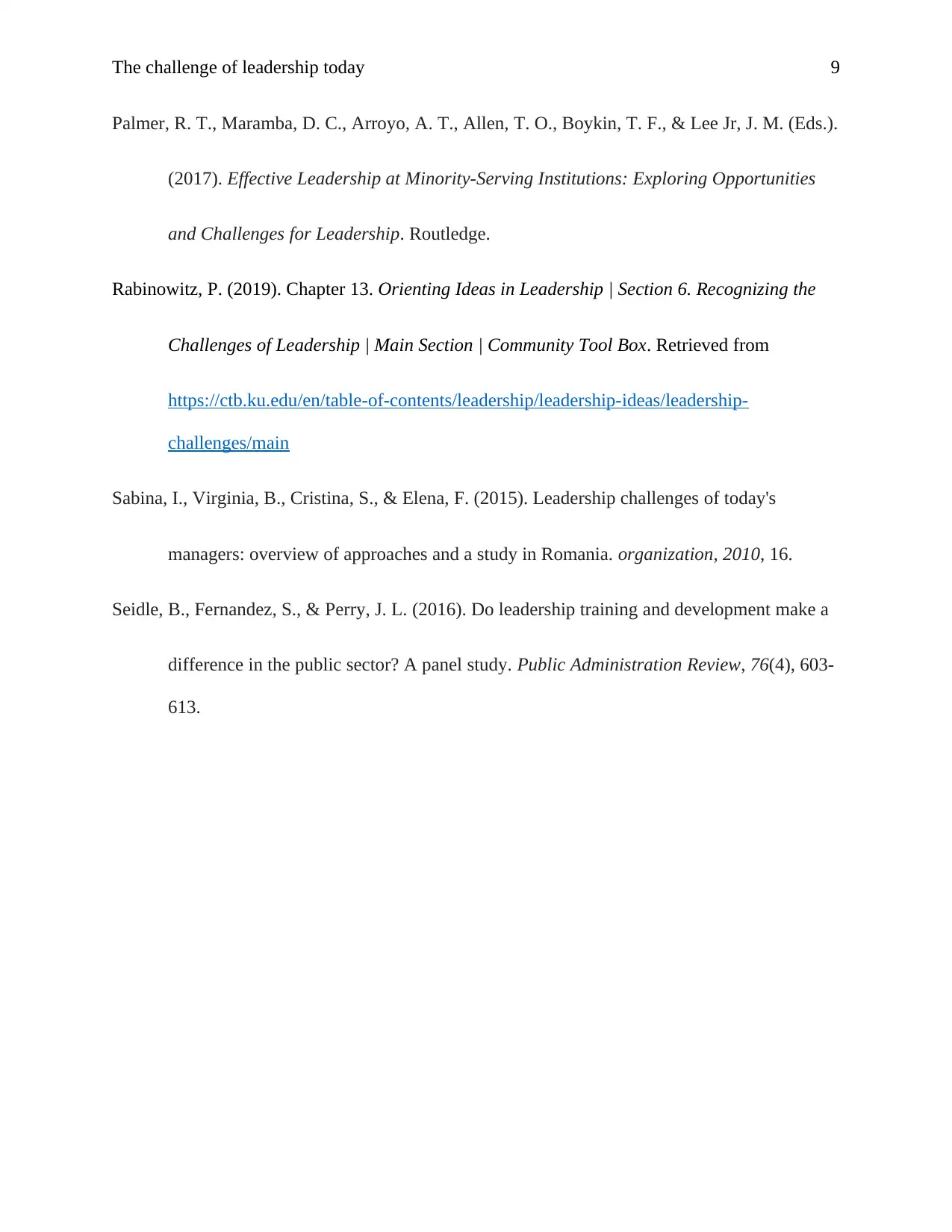
The challenge of leadership today 9
Palmer, R. T., Maramba, D. C., Arroyo, A. T., Allen, T. O., Boykin, T. F., & Lee Jr, J. M. (Eds.).
(2017). Effective Leadership at Minority-Serving Institutions: Exploring Opportunities
and Challenges for Leadership. Routledge.
Rabinowitz, P. (2019). Chapter 13. Orienting Ideas in Leadership | Section 6. Recognizing the
Challenges of Leadership | Main Section | Community Tool Box. Retrieved from
https://ctb.ku.edu/en/table-of-contents/leadership/leadership-ideas/leadership-
challenges/main
Sabina, I., Virginia, B., Cristina, S., & Elena, F. (2015). Leadership challenges of today's
managers: overview of approaches and a study in Romania. organization, 2010, 16.
Seidle, B., Fernandez, S., & Perry, J. L. (2016). Do leadership training and development make a
difference in the public sector? A panel study. Public Administration Review, 76(4), 603-
613.
Palmer, R. T., Maramba, D. C., Arroyo, A. T., Allen, T. O., Boykin, T. F., & Lee Jr, J. M. (Eds.).
(2017). Effective Leadership at Minority-Serving Institutions: Exploring Opportunities
and Challenges for Leadership. Routledge.
Rabinowitz, P. (2019). Chapter 13. Orienting Ideas in Leadership | Section 6. Recognizing the
Challenges of Leadership | Main Section | Community Tool Box. Retrieved from
https://ctb.ku.edu/en/table-of-contents/leadership/leadership-ideas/leadership-
challenges/main
Sabina, I., Virginia, B., Cristina, S., & Elena, F. (2015). Leadership challenges of today's
managers: overview of approaches and a study in Romania. organization, 2010, 16.
Seidle, B., Fernandez, S., & Perry, J. L. (2016). Do leadership training and development make a
difference in the public sector? A panel study. Public Administration Review, 76(4), 603-
613.
⊘ This is a preview!⊘
Do you want full access?
Subscribe today to unlock all pages.

Trusted by 1+ million students worldwide
1 out of 9
Related Documents
Your All-in-One AI-Powered Toolkit for Academic Success.
+13062052269
info@desklib.com
Available 24*7 on WhatsApp / Email
![[object Object]](/_next/static/media/star-bottom.7253800d.svg)
Unlock your academic potential
Copyright © 2020–2025 A2Z Services. All Rights Reserved. Developed and managed by ZUCOL.





